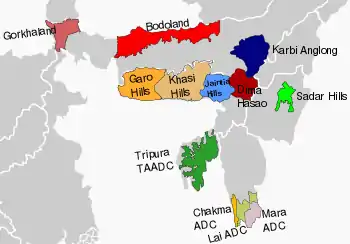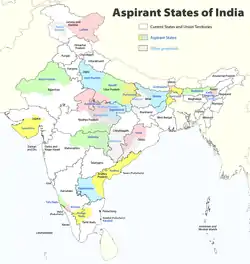Autonomous administrative divisions of India
The Sixth Schedule of the Constitution of India allows for the formation of autonomous administrative divisions which have been given autonomy within their respective states. [1] Most of these autonomous district councils are located in North East India but two are in Ladakh, a region administered by India as a union territory. Presently, 10 Autonomous Councils in Assam, Meghalaya, Mizoram and Tripura are formed by virtue of the Sixth Schedule [2] with the rest being formed as a result of other legislation.
 |
|---|
| This article is part of a series on the politics and government of India |
|
|


Powers and competencies
Executive and legislative powers
Under the provisions of the Sixth Schedule of the Constitution of India, autonomous district councils can make laws, rules and regulations in the following areas:[3]
- Land management
- Forest management
- Water resources
- Agriculture and cultivation
- Formation of village councils
- Public health
- Sanitation
- Village and town level policing
- Appointment of traditional chiefs and headmen
- Inheritance of property
- Marriage and divorce
- Social customs
- Money lending and trading
- Mining and minerals
Judicial powers
Autonomous district councils have powers to form courts to hear cases where both parties are members of Scheduled Tribes and the maximum sentence is less than 5 years in prison. [4]
Taxation and revenue
Autonomous district councils have powers to levy taxes, fees and tolls on; building and land, animals, vehicles, boats, entry of goods into the area, roads, ferries, bridges, employment and income and general taxes for the maintenance of schools and roads. [5]
List of autonomous administrative divisions
Autonomous district councils operating under the Sixth Schedule of the Constitution of India are shown in bold.
| State/Union Territory | Autonomous Council | Headquarters | Districts / Subdivisions | Formation | Last Election | Ruling Party |
|---|---|---|---|---|---|---|
| Assam | Bodoland | Kokrajhar | Baksa, Chirang, Kokrajhar, Udalguri | 2003 | 2020 | BJP & UPPL & GSP |
| Deori | Narayanpur | Lakhimpur | 2005 | 2016 | BJP | |
| North Cachar Hills (Dima Hasao) | Haflong | Dima Hasao | 1951 | 2019 | BJP | |
| Karbi Anglong | Diphu | Karbi Anglong, West Karbi Anglong | 1952 | 2017 | BJP | |
| Mising | Dhemaji | Dhemaji | 1995 | 2019 | BJP & SGS | |
| Rabha Hasong | Dudhnoi | Kamrup Rural, Goalpara | 1995 | 2019 | BJP & RHJMC | |
| Sonowal Kachari | Dibrugarh | 2005 | 2019 | BJP | ||
| Thengal Kachari | Titabar | 2005 | 2016 | BJP | ||
| Tiwa Autonomous Council | Morigaon | Kamrup (Metro), Morigaon, Nagaon and Hojai | 1995 | 2020 | BJP | |
| Ladakh | Kargil | Kargil | Kargil | 2018 | JKNC & BJP | |
| Leh | Leh | Leh | 2020 | BJP | ||
| Manipur | Chandel | Chandel | 2015 | |||
| Churachandpur | Churachandpur | 2015 | ||||
| Sadar Hills | Kangpokpi | Saikul, Saitu and Sadar Hills West subdivisions of Kangpokpi district | 2015 | |||
| Senapati | Senapati | 2015 | ||||
| Tamenglong | Tamenglong | 2015 | ||||
| Ukhul | Ukhrul | 2015 | ||||
| Meghalaya | Garo Hills | Tura | East Garo Hills, West Garo Hills, South Garo Hills, North Garo Hills and South West Garo Hills | 2015 | -- | |
| Jaintia Hills | Jowai | East Jaintia Hills, West Jaintia Hills | 1973 | 2019 | NPP & UDP | |
| Khasi Hills | Shillong | West Khasi Hills, East Khasi Hills and Ri Bhoi | 1973 | 2019 | UDP & NPP | |
| Mizoram | Chakma | Kamalanagar | Tuichawng subdivision | 2018 | MNF | |
| Lai | Lawngtlai | Lawngtlai subdivision, Sangau subdivision | 2020 | MNF | ||
| Mara | Siaha | Siaha subdivision, Tipa subdivision | 2017 | BJP | ||
| Tripura | Tripura Tribal Areas | Khumulwng | 2015 | -- | ||
| West Bengal | Gorkhaland | Darjeeling | Darjeeling, Kurseong and Mirik subdivisions of Darjeeling district, Kalimpong district | 2012 | -- |
De facto self-governing areas
North Sentinel Island
North Sentinel Island is situated in the island chain of the Andaman and Nicobar Islands which is a union territory of India. It is home to the Sentinelese people, who are among some of the world's last uncontacted peoples. They reject any contact with other people and are among the last people to remain virtually untouched by modern civilization. There has never been any treaty with the people of the island nor any record of a physical occupation.
The local government (Andaman and Nicobar Islands) has stated [6] that they have no intention to interfere with the Sentinelese's lifestyle or habitat. Although the island is likely to have suffered seriously from the effects of the December 2004 tsunami, the survival of the Sentinelese was confirmed when, some days after the event, an Indian government helicopter observed several of them, who shot arrows at the hovering aircraft to repel it.
Although this has not been done with any formal treaty, the official policy of minimal interference has ensured that they have de facto autonomy and sovereignty over their island under the framework of the central and local governments.[7]
References
- "Sixth Schedule of The Constitution of India" (PDF).
- https://www.firstpost.com/india/union-cabinet-approves-amendment-in-sixth-schedule-to-strengthen-10-north-east-autonomous-councils-5951561.html
- "Sixth Schedule of The Constitution of India" (PDF).
- "Sixth Schedule of The Constitution of India" (PDF).
- "Sixth Schedule of The Constitution of India" (PDF).
- The Sentineli Archived March 2, 2009, at the Wayback Machine.
- "Administration in India's Andaman and Nicobar Islands has finally decided upon a policy of minimal interference". Archived from the original on 2012-09-14. Retrieved 2008-08-21.
